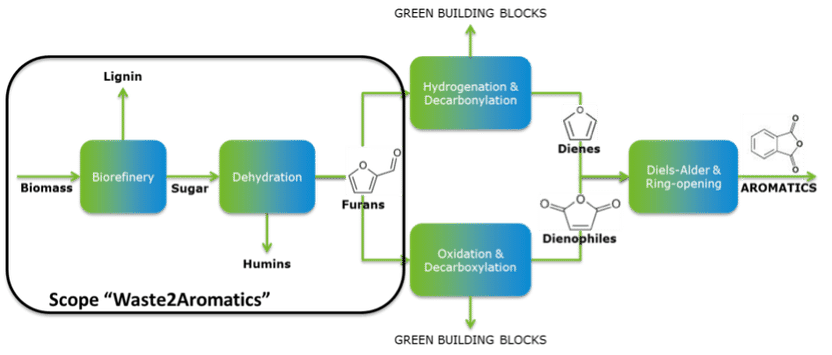Consortium scales up production of bio-aromatics from waste
Turning waste, that would otherwise be incinerated or end up in landfill, into valuable raw materials for the chemical industry is the challenge being undertaken by a consortium of 12 companies over the next 18 months. Biodegradable waste, nappies, compost and sieving material from wastewater will be converted to aromatic compounds, such as those used in the production of plastics. The innovative Waste2Aromatics project, from the Biorizon Shared Research Centre, will bring the commercial production of cost-competitive bio-aromatics, along with the circular economy, significantly closer.

Biorizon’s programme line ‘Sugars to Aromatics’, in which the Waste2Aromatics project plays a crucial role by developing technologies to supply cheap furans.
Biorizon
Aromatics are one of the main feedstocks of the chemical industry, constituting 40% of the total market. Currently, these are exclusively produced from fossil sources, generating considerable CO2 emissions. "This is a key milestone," says Monique Wekking, business development manager of Biorizon/TNO. "At the end of last year we convincingly proved that it is possible, on a lab scale, to convert waste streams into furans, the raw materials for aromatics, with a highly promising business case. We are now scaling up and working towards our ultimate goal: commercial production of bio-aromatics."
Unique collaboration: open innovation throughout the whole chain
A unique aspect of this follow-up project is the broad consortium in which all links of the value chain are represented: waste processors (Orgaworld, AEB, Twence, Association of Waste Processors, Knowaste), water treatment companies (Stowa, Waternet) and organisations (Biobased Delta, Amsterdam Port Authority), a designer and builder of pilot facilities (Zeton), and a large scale user of aromatics in the production of polymers (SABIC).
Under the Biorizon Shared Research flag TNO will coordinate the Waste2Aromatics project providing the technologies required to convert the waste streams. The project, with a budget 1.3 million euros, is being funded for 46% by the industrial consortium and for 53% by the Top consortium for Knowledge and Innovation (TKI) Chemistry.
From heterogeneous waste via furans to aromatics
To produce bio-aromatics from biodegradable waste, the (hemi)cellulose present in the organic fraction must be converted into furans. Two technologies, already proven on a lab scale, are employed for this catalytic thermochemical conversion: superheated steam (SHS) and bi-phasic reaction (BPR).
This project is geared to improving yield, reducing production costs and boosting confidence in the technologies by scaling up from laboratory to test scale (litre/hour). Attention is also being paid to the pre-treatment of waste streams, utilisation of by-products and the business case. Ultimately, the project will produce a blueprint for a pilot plant for the conversion of waste into furans that could be operational at a waste-processing company in 2019.
Topics
Organizations
Other news from the department science

Get the chemical industry in your inbox
By submitting this form you agree that LUMITOS AG will send you the newsletter(s) selected above by email. Your data will not be passed on to third parties. Your data will be stored and processed in accordance with our data protection regulations. LUMITOS may contact you by email for the purpose of advertising or market and opinion surveys. You can revoke your consent at any time without giving reasons to LUMITOS AG, Ernst-Augustin-Str. 2, 12489 Berlin, Germany or by e-mail at revoke@lumitos.com with effect for the future. In addition, each email contains a link to unsubscribe from the corresponding newsletter.



























































